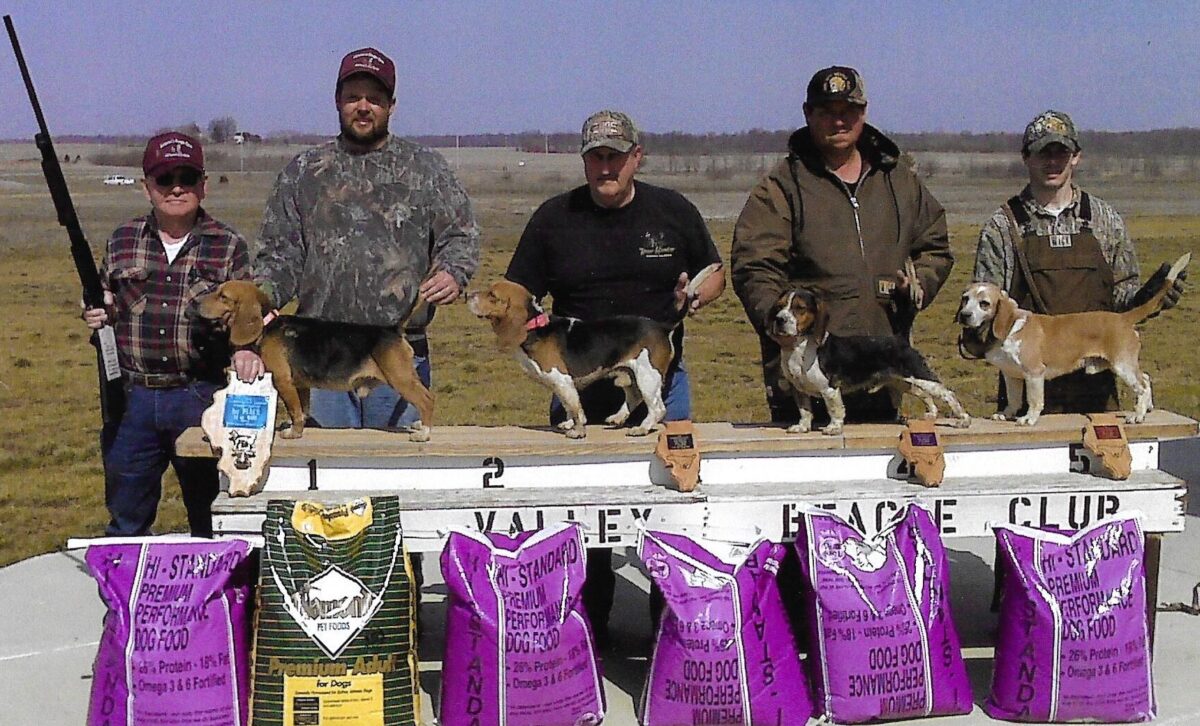DOGGONE!!!!
Many people fuss about ‘the dog days of summer,’ when it’s hot and sultry and nobody moves if they can help it. Glen Johnston, who lives just north of Akin, is in dog days all the time- and he enjoys it. He went to the dogs- more specifically beagles- as a boy and has been enthusiastic about them since.
He has more than a hundred of the compact dogs and has a lively breeding and training business going. He’s working to produce a line of white beagles, and the results so far look promising. He specialized in registered rabbit dogs. When he’s not digging it, he served as road commissioner for Eastern Franklin County Illinois (now retired).
“I’ve had beagles for about as long as I can remember,” he says, “and I’ve always been crazy about them. When I was a kid, we lived over where Rend Lake is now. Beagles weren’t all that common then, but I got hold of a three-quarter beagle- the owner said the other quarter was ‘something else,’ and I did a lot with that dog.”
He notes that when he was growing up, he would put out box traps for rabbits. “I’d take one of those little rascals and turn him out for the dog to run, and when the rabbit was tired, I’d catch him and take him home. That was supper.”
In his teens, Glen earned spending money by breeding, training and selling beagles. Like many Southern Illinoisians, he had to move north to find a good-paying job. He married his high school sweetheart, who had grown up near Macedonia, and they wound up in Chicago Heights, where he worked for Montgomery Ward. They spent 17 years there before the pull of Southern Illinois got to them and they moved back to do a little farming and beagle raising. Carolyn also worked as a part-time mail carrier. and is retired now.
It turned out that Glen was a lot more enthusiastic about dog farming that the other kind, so he sold off most of the Hereford brood cows and fenced in the old pasture with varmint enclosure wire, turning the two 40-acre pastures into a running ground for the dogs.
“In order for our beagles to have training in the wild,” Glen says, “we rent or lease 250 acres for additional running grounds. We keep wide paths mowed so the dogs and rabbits can be viewed. I try to run the beagles weekly. “I call my place a ‘beagle farm’ because I use the acreage for training beagles,” he says with a chuckle.
grounds. We keep wide paths mowed so the dogs and rabbits can be viewed. I try to run the beagles weekly. “I call my place a ‘beagle farm’ because I use the acreage for training beagles,” he says with a chuckle.
He still uses rabbits to train the dogs, but he doesn’t catch them in box traps and recycle them for supper. Instead, he gets domestic rabbits and turns them out. While the rabbits add some of the needed realism, he says, it’s not really the same.
“Domestic rabbits don’t have enough of a scent to enable the dogs to catch on to ’em, so the dogs have to work harder. Once the rabbits are out in the wilds for a while, they pick up an odor, and the dogs can get after ’em then,” he says.
Even so, once a good dog gets whiff of a rabbit, things start happening quickly, and a very excited dog is often the result. “And a very excited rabbit hunter, too,” Glen says.
It is a fact of life that animals in close quarters are prone to health problems unless care is taken to prevent such things, and Glen stresses that his operation is about as clean as you’ll find anywhere, and the dogs are well taken care of. “All our beagles are on a monthly routine medication of heart worm preventive and wormer. The animals are vaccinated with a seven-way medication to prevent parvo and distemper.
“We clean and disinfect our pens three times a week,” Glen says, “and the concrete under them is flushed into a gutter which flows into a small sewage lagoon. We use Sevin dust weekly to control insects such as ticks, fleas and mosquitoes.”
He adds that the dogs and their digs are frequently inspected by the Department of Agriculture personnel and AKC representatives.
– “Doggone!”; THE SOUTHEASTERN LIGHT – September, 1992.
